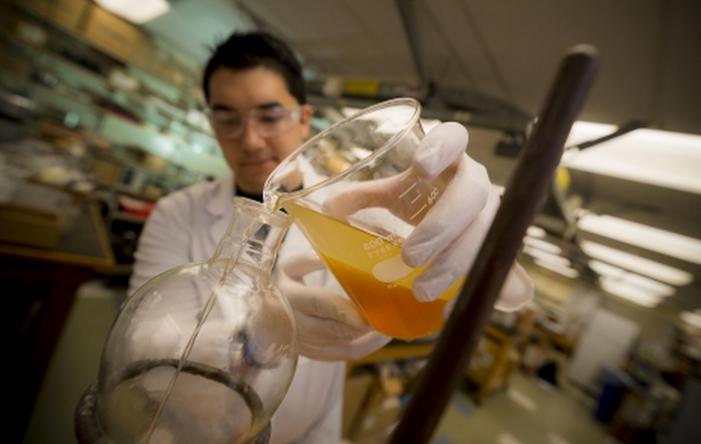Stephen Mayfield, a professor of biology and a geneticist at UC San Diego, has spent his career researching algae. As the director of the California Center for Algae Biotechnology, he has focused on improving the single-cell organism's productivity to make biofuels, spinning off Sapphire Energy in the process.
Mayfield has also been a surfer for 45 years. Like other surfers, he'd been resigned to living with a contradiction. While surfing gives him a close connection to nature, where "you're totally immersed in the ocean,” he explained that the special connection "is through a piece of plastic made from fossil fuels."
What's true for surfing is also true for much of modern manufacturing. Surfboards are made from fossil fuel-derived polyurethane foam. Polyurethane is made of polyvols, groups of liquid molecules that react with alcohol and become a polyurethane. It can be cooked, shaped, and molded to manufacture flexible or rigid foams, like those used in vehicle interiors; they are also used in coatings, sealants, and adhesives to produce an incredibly diverse array of products.
Bringing his two passions together
Mayfield finally decided to his end his wave-riding angst by bringing his two passions together. He had his undergraduate biology students join chemistry students and use algae to make the precursor of the polyurethane foam core of a surfboard. Then he shared his idea with Marty Gilchrist, the business director at Arctic Foam, the largest surfboard blank maker in the US, who agreed to help after he quickly realized the product’s game-changing potential.

But first Mayfield had to find enough pure algae oil — industrial quantities — to make the first batch of fifty surfboards. He contacted Solazyme, a San Francisco–based biotech firm that makes algae oil for a wide array of products, everything from drilling lubricants to an anti-wrinkle cream sold in Sephora.
Solazyme’s technology is based around bio-engineering algal strains. They are grown in fermentation tanks without light by feeding them sugar. Then, using existing industrial equipment, the company extracts the oil. The oil from Solazyme looked like vegetable oil when it got to the lab. The UC chemists added an alcohol to break the bonds and thicken the formula into polyurethane, creating a new compound with the viscosity of engine oil.
But adapting the new ingredient wasn’t easy. The students had to figure out how to change algae oil into polyols. Once they got the chemistry right, Arctic Foam came in to make the boards. They added their catalyst, a secret mixture of silicate-like sand or glass, that hardened the compound inside a surfboard-shaped mold. The first two boards were complete failures. One came out too rubbery, and one expanded until it exploded — par for the course with first-generation tinkering — but it flattened the learning curve.
It was finally cooked into a block and shaped using a computer. Gilchrist thinks the new board will perform better than typical boards because of a denser cell pattern that provides surfer's with a trifecta of benefits: it's harder, more flexible, and more buoyant. The boards were finished by coating them with renewable resin and fiberglas.
A new revenue stream
Although the board’s core is made from algae, it is pure white and indistinguishable from petroleum-based surfboards because the oil from algae is clear. The first experimental board had logos from Arctic Foam, Solazyme, the California Center for Algae Biotechnology and the US Department of Energy, which funds Mayfield’s research.
By using algae, Mayfield and his students have replaced fossil fuel-derived chemicals. If this starts a trend and algae finds its way into more products, it could provide a crucial revenue for start-ups like Solazyme that are working to meet the DOE's goal of $3 per gallon fuel by 2030.
After Arctic Foam fine-tunes the new formula from feedback by professional surfers, Gilchrist is ready to takeover the whole market. "Once the pros sign off on it, we’re going to start mass production.” UCSD will soon pass production of the polyols over to an industrial lab to produce them on a mass scale with the goal of making the boards commercially within three to six months. There’s no cost estimate yet, but Arctic Foam hopes to bring it close to the market norm of about $600.


